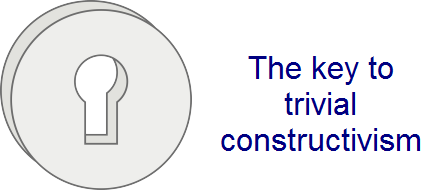 Jean Piaget described the learning process as continuous interactions between existing cognitive structure (schemes) and new experience (1969). Specifically, learning process takes place through the organisation of information (schemes), the placing of new knowledge/information into schemes (assimilation) and the transformation of information into existing schemes or creating new one (accommodation). Learners receive information, construct their own new mental model and accommodate it within a previously existing one or creating a new one (a bridge links it with a previously existing one, if it is necessary). Sometimes through the learning process occurs a cognitive conflict causing to learners “dissatisfaction” with their existing scheme. Result of the conflict process is learners to search for a new mental model which should synthesise the different perspectives for the same topic and to bring an equilibrium in learners’ mind. This is an active learning process, as there is a continuous interactions among the existing schemes, assimilation, accommodation and equilibrium of the new knowledge with their old models. Learners go through this process alone and teachers cannot interfere with this process, as only learners should discover learning.
Jean Piaget described the learning process as continuous interactions between existing cognitive structure (schemes) and new experience (1969). Specifically, learning process takes place through the organisation of information (schemes), the placing of new knowledge/information into schemes (assimilation) and the transformation of information into existing schemes or creating new one (accommodation). Learners receive information, construct their own new mental model and accommodate it within a previously existing one or creating a new one (a bridge links it with a previously existing one, if it is necessary). Sometimes through the learning process occurs a cognitive conflict causing to learners “dissatisfaction” with their existing scheme. Result of the conflict process is learners to search for a new mental model which should synthesise the different perspectives for the same topic and to bring an equilibrium in learners’ mind. This is an active learning process, as there is a continuous interactions among the existing schemes, assimilation, accommodation and equilibrium of the new knowledge with their old models. Learners go through this process alone and teachers cannot interfere with this process, as only learners should discover learning.
Bruner adopted the discovery and active learning process from Piaget’s work and described a framework which involved a dialog process (1966). The learning process would address the curiosity through an internal dialog which led learners to ask if the new information confirmed or refined their previous knowledge, what else this knowledge could offer to them compare with their existing model and if this new knowledge was relevant to the old schemes. This is an internal process which leads to a goal-directed learning. Instructions and culture play an important role in this learning theory, as instructions should provide experience increasing learners’ curiosity, should support the internal reconstruction of the knowledge and motivate them to go beyond the provided information. Additionally, culture support a framework where learners could predict what would happen in the future.
The two learning theories accept interactions among learners, which might support discovery learning process, but these interactions might influence learners’ reconsideration of existing schemes and formulation of new ones. Thus, the trivial constructivism as was developed by Piaget and Bruner has a serious argument which is based on the assumption that learners’ process support knowledge construction, but learners are always in interaction with the external reality (von Glasersfeld, 2007) (radical constructivism). The two propositions of radical constructivism are that learning is an active process where learners receive information through either the senses or communications with others, and learning process is supported in an experiential world rather than a discovery of an objective ontological reality (Cato, 2006).
References
Bruner, J. (1966). Toward a Theory of Instruction. Cambridge, MA: Harvard University Press.
Cato, D. (2006). Of the trivial and the radical: is there a coherent constructivist pedagogy? Paideusis, 15(1), 57-74. http://journals.sfu.ca/paideusis/index.php/paideusis/article/viewFile/39/2
Piaget, J. (1969). The Mechanisms of Perception. London: Rutledge & Kegan Paul.
von Glasersfeld, E. (2007). An exposition of constructivism: why some like it radical. Italy: Associazione Oikos. http://www.oikos.org/constructivism.htm

Trivial and Radical Constructivism by Maria Limniou is licensed under a Creative Commons Attribution-NonCommercial-ShareAlike 3.0 Unported License.
